#cushite
Explore tagged Tumblr posts
Text

27 notes
·
View notes
Text
An Attitude of Ingratitude
19 Then Ahimaaz the son of Zadok said, “Let me run and carry news to the king that the Lord has delivered him from the hand of his enemies.” 20 And Joab said to him, “You are not to carry news today. You may carry news another day, but today you shall carry no news, because the king’s son is dead.” 21 Then Joab said to the Cushite, “Go, tell the king what you have seen.” The Cushite bowed before…
#2 Samuel 18#Absalom#Ahimaaz#Cushite#David#deliverance#gratefulness#Joab#obedience#Samuel#shepherd#sovereignty#thankfulness#the death of Absalom#the will of God#victory
0 notes
Text

If you ever thought the proliferation of endonyms vs. exonyms of Uralic languages is hard to keep track of: for some reason Cushitic is easily 3× worse, typically there's at least an endonym + local exonym + Amharic exonym + Italian rendering of either exonym; and at its worst it goes up to… this
88 notes
·
View notes
Text
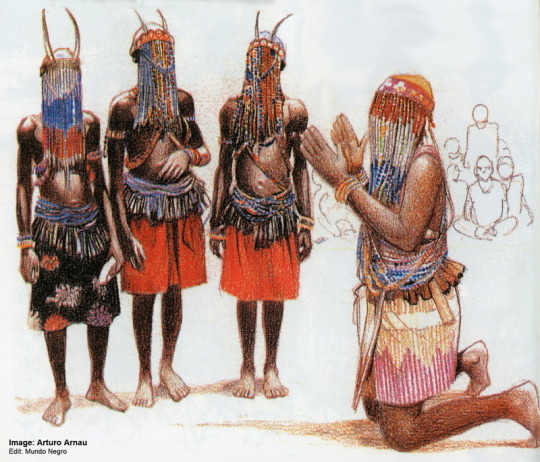
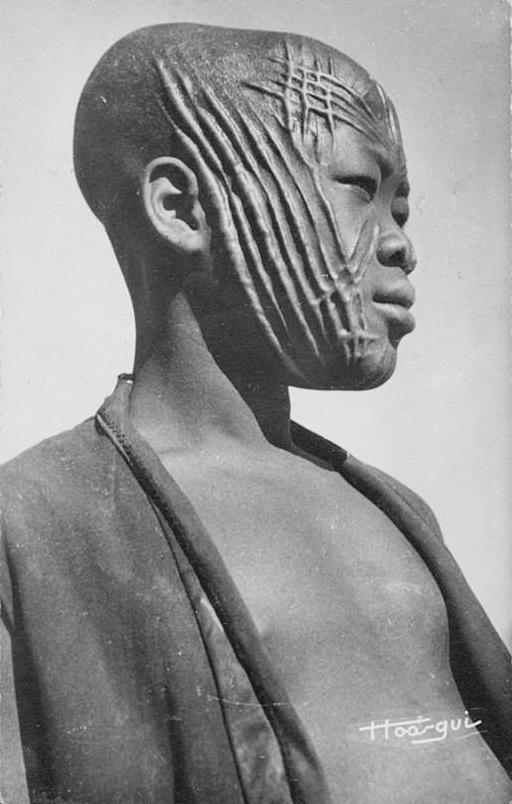
Analysis of classic genetic markers and DNA polymorphisms by Excoffier et al. (1987) found that the Sara are most closely related to the Kunama people of Eritrea.
Both populations speak languages from the Nilo-Saharan family. They are also similar to West African populations, but biologically distinct from the surrounding Cushitic and Ethiopian Semitic Afro-Asiatic-speaking groups
The Sara people are a Central Sudanic ethnic group native to southern Chad, the northwestern areas of the Central African Republic, and the southern border of North Sudan. They speak the Sara languages which are a part of the Central Sudanic language family. They are also the largest ethnic group in Chad.
Sara oral histories add further details about the people. In summary, the Sara are mostly animists (veneration of nature), with a social order made up of several patrilineal clans formerly united into a single polity with a national language, national identity, and national religion.
#african#afrakan#kemetic dreams#africans#brownskin#brown skin#afrakans#african culture#eritrea#kunama#nilo saharan#cushitic#ethiopian#afro asiatic#dna polymorphisms#dna test#dna#sara people#sara ethnic#chad#animists#afrakan spirituality
34 notes
·
View notes
Text
Lots of people complaining about The Mummy vs the new Cleopatra documentary but therein lies the issue: Cleopatra is claiming to be a historically accurate documentary, it is claiming to tell the “real” truth and even put out a statement on how Cleopatra’s ethnicity has been long debated (which, among scholars, no it really hasn’t, y’all just keep ignoring us when we say Cleopatra wasn’t black), but now they’re here to tell the real story that Cleopatra was really black and so was everyone in Egypt, especially the ruling class, at a time where they definitely were not as they were being ruled over by the Ptolemaic Greeks, while The Mummy was not claiming any historical accuracy or to be a documentary of real events, and that’s where a lot of the backlash is coming from.
#The most annoying part is that if you wanted to make a documentary about like#Someone who actually was Nubian or Cushite or whatever as the Egyptians called it#YOU COULD.#There were dark-skinned pharaohs and queens we know this#Do something about Queen Tiye or whomever#One of the other foreign dynasties that ruled Egypt that we know about#Smh people keep bringing up Cleopatra’s ethnicity like it’s still open for debate when it’s really not#Because they just want her to be black so badly even though she most emphatically was not#And lbr it’s mostly Americans doing this#Because Americans can’t conceive that other countries have different racial dynamics or makeup#And they can’t conceive that sub-Saharan Africa isn’t actually indicative of the ethnic makeup of all of Africa#text
42 notes
·
View notes
Text
The History and Influence of the Blemmyan kingdom & Blemmyes
The Blemmyan kingdom and the Blemmyes have left an indelible mark on history, shrouded in mystery and fascination. The ancient kingdom of the Blemmyes, also known as the Blemmyan, is a testament to the rich tapestry of African history and the enduring legacy of its people. Situated in the Nile Valley, the Blemmyan kingdom thrived from around the 5th century BC to the 4th century AD, encompassing…
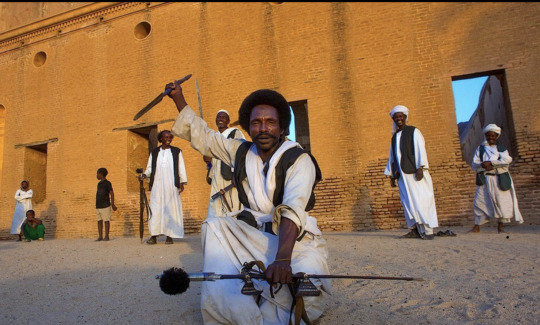
View On WordPress
#African empire#African empires#African History#African kingdom#african kingdoms#Beja people#Beja society#Blemmyan kingdom#Blemmyes#Cushitic ethnic group#Nile Valley#Nile Valley civilisation
0 notes
Text
Distortion of Cushitic & Hamitic-Berber History by Western Forgers: Africa's Endless Enslavement
Brief presentation by Prof. Muhammad Shamsaddin Megalommatis
Table of Contents
I. Berbers
II. The Fallacy of Pan-Arabism
III. Hamitic-Cushitic Historical Heritage Usurped
IV. Hamites & Cushites systematically targeted
V. Anti-Hamitic Hysteria of Western Academics
VI. The Embarrassing History of the Berbers
------------------------------------
Read and download the 2400-word text here:
and
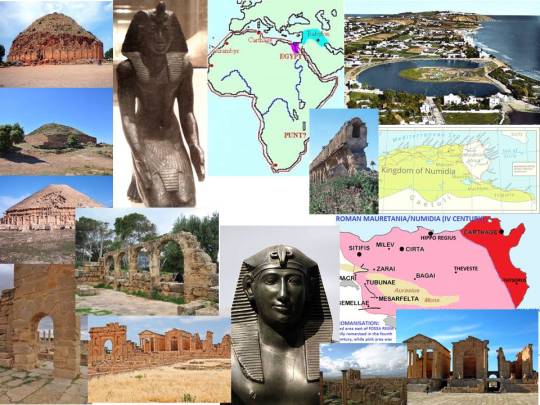

#Cushites#Hamites#Hamitic#Cushitic#Cush#Ham#Kemet#Egypt#Sudan#Ethiopia#Abyssinia#Oromo#Afar#Sidama#Kaffa#Hadiya#Sheka#Kambata#Panarabism#Tunis#Libya#Nechao#Necho#Psamtek#Psammetichus#26th dynasty#Berbers#Algeria#Atlas#Morocco
0 notes
Text
I RAMBLED A LOT IN THE NOTES BUT I SWEAR IMMA HELP YOU WHEN I GET KN MY COMPUTWR
Kalim's Birthday Fanart
As some of you may be aware already, for each twst character’s birthday i tend to make art of the birthday boy to celebrate, and my plan for this year was to use said art to promote different charities and local stores from countries in need. The next birthday on the list is Kalim’s and I wanted to make it special to promote a lot more charities than usual in a single post for the following countries: Iraq, Jordan, Lebanon, Palestine, Syria, Turkey, Tunisia and Yemen (I wanted to include Sudan as well, but I’m not sure if it would be okay to do so given the fact that it’s in Northeast Africa, either way I’ll be making another special art piece focused on African countries for Leona’s birthday but I really want to add Sudan to Kalim and Jamil’s art as well, please do let me know if that’s alright).
My plan for these is to put Kalim in these countries’ different traditional clothing (yes, all of them if possible, I like to put the boys in at least 2 different outfits for their birthday and I don’t mind putting them in more if given enough time), and while I’ve found something in my investigation I also feel unsure of how accurate said information is, as well as the fact that I haven’t been able to find good reference for each article of clothing (most pics I’ve found are low res and I can’t see the details like that). So, after consulting with my sister about it, I decided to make this post to ask for help for this, since I’m not from any of the countries mentioned and I truly don’t want to end up doing something offensive due to lack of information when my objective is to try and bring more attention to what is happening there and hopefully spread the charity links to help the victims.
So please, if you can help me in any way to verify the information I gathered or link me more sources and references I can use (especially if you’re a part of any of these cultures) I would be incredibly grateful!
Notes and List of sites I gathered and consulted under Read More.
Notes:
My plan for Kalim’s outfits based on the information I have so far goes like this:
First outfit: white Thobe w/ embroidered neckline and cuffs + red and white Kuffiyeh/Shumagh (possibly over his shoulders instead of in his head, but I might change it) – OR – Kurdish traditional clothing (sharwall, long sleeved jacket, dress shirt and pshtwen/pshten).
Second Outfit: simple white Dishdasha + Champagne colored Bisht (given his social standing, please let me know if it’s innapropiate) + classic black and white Kuffiyeh/Shumagh.
Third Outfit: Dishdasha w/ blazer + embroidered belt + Jambiya + Shawl wrapped like a turban (colors and patterns not yet decided).
Fourth Outfit: Jalabiya + scarf + skullcap (colors and patterns not yet decided).
I don’t really know if that number of outfits is enough to represent all of the mentioned cultures or if I should add more, so please let me know! I’m also trying to find more reference pictures so that I can be as accurate as possible, so links to online shops that sell these garments also work pretty well for me (preferably, with models wearing them so I can see how the fabrics and layers interact with movement).
Sources I’ve found/consulted so far:
Arab Clothing: The Ultimate Guide | IstiZada
Video: Muslim Dresses Around The World Countries 2022 | Islamic Traditional Cloth For Men | Islamic Updates - YouTube
What is a dishdasha and how is it worn? (custom-qamis.com)
What is the Difference Between a Thobe and Dishdasha? – newarabia
Bisht | Abu Dhabi Culture
Clothing – The School of Abbasid Studies
Home - Nationalclothing.org
Clothing - Kurdish Central
Again, thank you so much for the help! If you also want to send me links of charities whose proceeds go to the mentioned countries, that would be just as appreciated!
#SCREAMING THIS IS SUCH A GOOD IDEA#IM YEMENI WITH DISTANT IRAQI ROOTS ON MAMAS SIDE#SOMEONE REMIND ME TO REPLY TO THIS POST WHEN I GET OJT OF BED AND ONTO MY COMPUTER#twisted wonderland#kalim al asim#jamil viper#twst fanart#also i do recommend not including sudan since sudanese people are not arab despite speaking arabic due to their region#sudan has been arabized due to its region and expansionism#the nubian languages/dialects are in decline as a result of it#afro-arabs and black arabs do exist though#i just wanted to say that#the african and arab debate has gone on forever and the results are always just people screaming back and forth#arabs are semitic and the people of sudan are not#colorism also plays a huge role in it too#i will say that there have been arabs in sudan for centuries but that just mirrors the effects of the yemenis in somalia#africa and the Middle East are right next door to each other#so of course there’s mixing#also you can speak semitic languages without being semitic in your roots#the ethiopians are a group of africans that come to mind when i think of african semites as well as the mixed people of socotra island#the native languages of sudan that aren’t arabic don’t come from the semitic tree#think beja being a cushitic language and nubian/fur being their own groups of language#there are cushitic people in ethiopia as well#but due to their proximity to yemen and the red sea they have a lot of semitic tribes as well#the same can’t be said about sudan who had semitic people#expand into their lands and so on#while im sure there’s native arabs to sudan#the fact of the matter is the native cultures of sudan have been dying due to many things such as colonialism#but also rancid arab superiority and colorism
34 notes
·
View notes
Text






The Oromos are the largest ethnic group in Ethiopia and one of the largest in Africa. They are primarily located in Ethiopia 🇪🇹 but there are also significant populations in Kenya 🇰🇪 and Somalia 🇸🇴 The Oromos have a rich cultural heritage and are known for their unique cultural practices, such as the gadaa system of governance, which is based on age grades.
The Oromo language is a Cushitic language spoken by the Oromo people in Ethiopia, Kenya, and Somalia. It is the most widely spoken language in Ethiopia and is the third-largest language in Africa.
91 notes
·
View notes
Text
(Ethiopia, South West Ethiopia People's Region)
Among many of the Cushite and Omotic speaking tribes, it was traditional for men to carry the children. Attempts to suppress this practice were made during the Italian occupation and the post-war Ethiopian Empire, but were largely unsuccessful. Some anthropologists have associated the practice of male pregnancy with the early spread of agriculture. It level-loads child rearing, with the men undergoing pregnancy while the women nurse infants, increasing the fertility rates. Likewise, the suppression of the practice has been linked to reducing overpopulation or increasing the percentage of men capable of going to war at any given time.
#mpreg#mpreg ai#mpreg video#mpreg ai video#male pregnancy#pregnant man#pregnant men#mpreg indigenous#mpreg lore
76 notes
·
View notes
Note
Do you have any literature on sound changes involving ejective consonants? Specifically ejective consonants changing into something else?
I don't know of any general surveys, but several individual cases are of course found in literature in more detail. It would be worthwhile to have some compiled data on this though! For a start I'll collect some examples in this post.
The best-described case might be Semitic, where any handbook (or even just the Wikipedia article) will inform you about *kʼ > q, tsʼ > (t)s etc. being attested in Arabic / Aramaic / Hebrew. Offhand I don't know if there is a particular locus classicus on the issue of reconstructing ejectives for Proto-Semitic, though.
---
Cushitic, which I've been recently talking about, has open questions remaining especially in what exactly to reconstruct for various correspondences involving ejective affricates, but at least the development of the ejective stops seems to be well-established. Going first mainly per Sasse (1979), The Consonant Phonemes of Proto-East Cushitic, Afroasiatic Linguistics 7/1, three developments into something else appear across East Cushitic for *tʼ:
*tʼ > /ɗ/ (alveolar implosive): Oromo, Boni, Arboroid (Arbore, Daasenech, Elmolo), Dullay, Yaaku and, at least word-internally, Highland East Cushitic.
*tʼ >> /ᶑ/ (retroflex implosive): Konsoid (Konso, Dirasha a.k.a. Gidole, Bussa). (As per Tesfaye 2020, The Comparative Phonology of Konsoid, Macrolinguistics 8/2. Some other descriptions give these too as alveolar /ɗ/.)
*tʼ >>> /ɖ/ (retroflex voiced plosive): Saho–Afar, Somali, Rendille.
Presumably these all happen along a common path *tʼ > ⁽*⁾ɗ > ⁽*⁾ᶑ > ɖ. Note though that Sasse reconstructs *ɗ and not *tʼ — but comparison with the case of *kʼ, the cognates elsewhere in Cushitic, and /tʼ/ in Dahalo and word-initially in Highland East Cushitic I think all point to *tʼ in the last common ancestor of East Cushitic. (As per other literature, I don't think East Cushitic is necessarily a valid subgroup and so this last common ancestor may also be ancestral to some of the other branches of Cushitic.)
For *kʼ there is a wide variety of secondary reflexes:
Saho–Afar: *kʼ > /k/ ~ /ʔ/ ~ zero (unclear conditions).
Konso: *kʼ > /ʛ/ (no change in Bussa & Dirasha).
Daasenech: *kʼ > /ɠ/ word-initially, else > /ʔ/.
Elmolo: *kʼ > zero word-initially, else > /ɠ/.
Bayso: *kʼ > zero.
Somali: *kʼ > /q/, which varies as [q], [ɢ] etc.; merges in Southern Somali into /x/). Before front vowels, > /dʒ/.
Rendille: *kʼ > /x/.
Boni: *kʼ > /ʔ/.
though some of them again could be grouped along common pathways like *kʼ > *q > *χ > x, *kʼ > *ʔ > zero.
*čʼ > /ʄ/ happens at minimum in Konso (corresponds to /tʃʼ/ in Bussa & Dirasha). Proposed developments of a type *čʼ >> /ɗ/ in some other languages could go thru a merger with *tʼ first of all.
No East Cushitic *pʼ seems to be reconstructible, but narrower groups show *pʼ > /ɓ/ in Konsoid (corresponds to Oromo /pʼ/) and maybe *pʼ > /ʔ/ in Sidaamo (corresponds to Gedeo /pʼ/; mainly in loans from Oromo).
There is also an unpublished PhD from University of California at LA: Linda Arvanites (1991), The Glottalic Phonemes of Proto-Eastern Cushitic. I would be interested if someone else has access to this (edit: has been procured, thank you!)
Secondary developments of *tʼ and *kʼ in the rest of Cushitic, per Ehret (1987), Proto-Cushitic Reconstruction, Sprache und Geschichte in Afrika 8 (he also reconstructs *pʼ *tsʼ *čʼ *tɬʼ, but I'm less trustful of their validity):
Beja: *tʼ > /s/, *kʼ > /k/.
Agaw: *tʼ > *ts (further > /ʃ/ in Bilin and Kemant), *kʼ > *q (further word-initially > /x/ in Xamtanga and Kemant, /ʁ/ in Awngi)
West Rift: *kʼ > *q (and *tʼ > *tsʼ).
(The tendency for assibilation of *tʼ is interesting; although plenty of Cushitic languages get rid of ejectives entirely, none seems to have a native sound change *tʼ > /t/.)
---
The historical phonology of the largest Afrasian branch, Chadic, is much more of a work in progress, but I would trust at least the following points as noted e.g. by Russell Schuh (2017), A Chadic Cornucopia:
*tʼ > *ɗ perhaps already in Proto-Chadic (supposedly all Chadic languages have /ɗ/);
*kʼ > /ɠ/ in Tera (Central Chadic);
/tsʼ/ in Hausa and some other languages corresponds to /ʄ/ or /ʔʲ/ in some other West Chadic languages, not entirely clear though which side is more original.
Tera /ɠ/ alas does not seem to be discussed in detail in the Leiden University PhD thesis by Richard Gravina (2014), The phonology of Proto-Central Chadic; he e.g. asserts /ɠəɬ/ 'bone' to be an irregular development from *ɗiɬ, while Schuch takes it as a cognate of e.g. Hausa /kʼàʃī/ 'bone'. (Are there two etyma here, or might the other involved Central Chadic languages have *ɠ > /ɗ/?)
If Olga Stolbova (2016), Chadic Etymological Dictionary is to be trusted (I've not done any vetting of its quality) then Hausa /tsʼ/ is indeed already from Proto-Chadic *tsʼ, and elsewhere in Chadic often yields /s/, sometimes /ts/ or /h/. Her Proto-Chadic *kʼ mostly merges with /k/ when not surviving. (She also has an alleged *tʼ with no ejective reflexes anywhere, and alleged *čʼ and *tɬʼ which mostly fall together with *tsʼ, but also show some slightly divergent reflexes like /ʃ/, /ɬ/ respectively.)
---
Moving on, a few other examples I'm aware of OTTOMH include the cases of word-medial voicing in several Koman languages and in some branches of Northeast Caucasian (Chechen and Ingush in Nakh; *pʼ in most Lezgic languages). Also in NEC, the Lezgic group shows complicated decay of geminate ejectives, broadly:
> plain voiceless geminate in Lezgian, Tabassaran & Agul (same also in Tindi within the Andic group);
> voiceless singleton (aspirated) in Kryz & Budux;
Rutul & Tsaxur show some of both of the previous depending on the consonant, as well as word-initially *tsʼː > /d/ and *tɬʼː > /g/ — probably by feeding into the more general shift *voiceless geminate > *unaspirated > voiced (which happens in almost all of Lezgic).
in Udi, both short and geminate ejectives > plain voiceless geminates (plus a few POA quirks like *qʼʷ > /pː/, even though *qʷ > /q/).
Again I don't know if this has been described in better detail anywhere in literature, this is pulled just from the overviews in the North Caucasian Etymological Dictionary plus some review of the etymological data by myself.
Ejectives in Kartvelian are mostly stable in manner of articulation, but there's a minor sound correspondence between Karto-Zan *cʼ₁ (probably = /tʃʼ/) versus Svan /h/ that newer sources like Heinz Fähnrich (2007), Kartwelisches Etymologisches Wörterbuch for some reason reconstruct as *tɬʼ or *tɬ. The Svan development would then probably go as *tɬ⁽ʼ⁾ > *ɬ > /h/, after original PKv *ɬ > /l/.
I do not know very much about the historical phonology of any American languages, including if there's anything interesting happening to ejectives there; if someone else around here does, please do tell!
#phonology#phonotypology#ejectives#historical linguistics#sound change#anonymous#cushitic#chadic#lezgic#kartvelian
23 notes
·
View notes
Text
What makes Habesha Ethiopians look so unique?
#dna #ancestry #ethiopians #habesha #cushitic #semitic
18 notes
·
View notes
Text


This is a message to my black brothers and sisters
Learn about your history
Ethiopia is one of the oldest countries in Africa; the emergence of Ethiopian civilization dates back thousands of years. Abyssinia or rather "Ze Etiyopia" was ruled by the Semitic Abyssinians (Habesha) composed mainly of the Amhara and Tigray, the Cushitic Agaw. In the Eastern escarpment of the Ethiopian highlands and more so the lowlands was the home of the Arab-descended Harari that founded Sultanates such as Ifat and Adal and the Afars. In the central and south were found the ancient Sidama and Semitic Gurage, among otheres. One of the first kingdoms to rise to power in the territory was the kingdom of D'mt in the 10th century BC, which established its capital at Yeha. In the first century AD the Aksumite Kingdom rose to power in the modern Tigray Region with its capital at Aksum and grew into a major power on the Red Sea, subjugating South Arabia and Meroe and its surrounding areas. In the early fourth century, during the reign of Ezana, Christianity was declared the state religion. Ezana's reign is also when the Aksumites first identified themselves as "Ethiopians", and not long after, Philostorgius became the first foreign author to call the Aksumites Ethiopians.[The Aksumite empire fell into decline with the rise of Islam in the Arabian peninsula, which slowly shifted trade away from the Christian Aksum.[citation needed] It eventually became isolated, its economy slumped and Aksum's commercial domination of the region ended.The Aksumites gave way to the Zagwe dynasty, who established a new capital at Lalibela before giving way to the Solomonic dynasty in the 13th century. During the early Solomonic period, Ethiopia went through military reforms and imperial expansion that allowed it to dominate the Horn of Africa.
How did Ethiopia Resist Imperialism?
Ethiopia, formerly Abyssinia, is one of the world’s oldest countries. Dating to around 400 BCE, the region is documented in the in the King James Version of the Bible as the Kingdom of Axum. Along with Rome, Persia, and China, Axum was considered one of the four great powers of the era. Throughout the millennia of its history, the willingness of the country’s people—from farmers to kings—to come together as one, coupled with its geographic isolation and economic prosperity, helped Ethiopia score decisive victories against a series of global colonialist forces.
Ethiopia is considered “never colonized” by some scholars, despite Italy's occupation from 1936–1941 because it did not result in a lasting colonial administration.
Seeking to expand its already considerable colonial empire in Africa, Italy invaded Ethiopia in 1895. In the ensuing First Italo-Ethiopian War (1895-1896), Ethiopian troops won a crushing victory over Italian forces at the Battle of Adwa on March 1, 1896. On October 23, 1896, Italy agreed to the Treaty of Addis Ababa, ending the war and recognizing Ethiopia as an independent state.
On Oct. 3, 1935, Italian dictator Benito Mussolini, hoping to rebuild his nation’s prestige lost in the Battle of Adwa, ordered a second invasion of Ethiopia. On May 9, 1936, Italy succeeded in annexing Ethiopia. On June 1 of that year, the country was merged with Eritrea and Italian Somalia to form Africa Orientale Italiana (AOI or Italian East Africa).
Ethiopian Emperor Haile Selassie made an impassioned appeal for assistance in removing the Italians and re-establishing independence to the League of Nations on June 30, 1936, gaining support from the U.S. and Russia. But many League of Nations members, including Britain and France, recognized Italian colonization.
It was not until May 5, 1941, when Selassie was restored to the Ethiopian throne, that independence was regained.
Ethiopia's ability to resist being swept up in the "Scramble for Africa" can be credited to the stability of its longstanding imperial government, beginning with the Abyssinian Empire in the 13th century, and lasting into the late 20th century, with the exception of a brief Italian occupation during the 1930s. King Menelik II, the Emperor during the period of rampant European exploration and colonization in Africa, was careful to cultivate an alliance with the smaller surrounding kingdoms of North Africa, and with European powers including Italy and Russia. When Italy began to turn the sights of their imperial ambitions toward Ethiopia, the Ethiopian military became the only African kingdom able to successfully resist the military might of European colonial power, using Russian-supplied weapons to defeat the Italian invading force at the Battle of Adwa in 1896. In the aftermath of the battle, in exchange for permanent recognition as an independent empire, Menelik II granted Italy the right to claim the neighboring territory of Eritrea under their imperial umbrella.
Ethiopians have a history of taming lions.
Many Emperors kept pet lions including Halie Selassie. Occasionally visitors like Kwame Nkrumah could pet one of the lions!
This practice of keeping lions is said to date back thousands of years to the Axumite period.The descendants of the Royal Lions currently live in the Addis Ababa zoo.
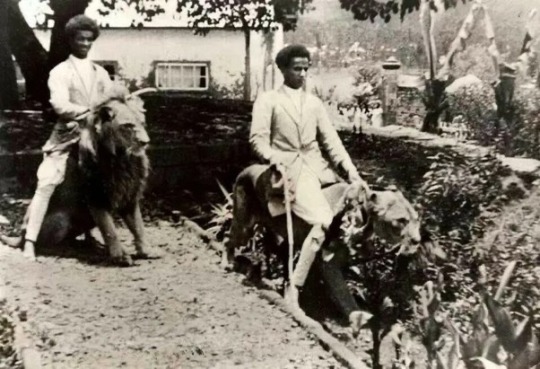
Meet his imperial majesty, the King of the Jungle.
And if, with his thick, shaggy mane Challa seems to have something of a frisky regal air about him - it's because he knows that he is a genuine blue blood.Challa is a direct descendant of Mochuria and Mollua - royal lions, which the late Emperor Haile Selassie kept as pets. The Emperor's practice of keeping pet lions is said to date thousands of years back to the Axumite period.Years ago in Ethiopia, Lions were pets to the people, some were used like donkeys, some like dogs kept at home. Emperor Haile Selassie of Ethiopia had lions he kept as pets, while some Ethiopians could even ride on them. These were not wild lions, they grew up with humans and became domesticated.They didn't go after human blood or other animals, lions roamed around the streets of Ethiopia and live was beautiful with them. Ethiopia is in East Africa, it's a rugged, landlocked country split by the Great Rift Valley, Ethiopia is a place of ancient culture, they believe and still hold on to ancient affairs.
Any lion that goes wild was immediately hunted killed, they were only killed if they kill a human and not animals like goats and chickens. They forbid killing and eating of any lion because lions were pets used in different palaces.
Ethiopia as a country had its origin in about 980 B.C., which makes it one of the oldest nations in the world.
Due to this very long history and an unmatched diversity of people and cultures, the country has often been described as a “museum of peoples”. With such a highly diverse population, Ethiopia houses an intricate tapestry of language and ethnic groups.
Also nicknamed the “Land of 13 Sunshine’s”, Ethiopia is often described as one of the most enthralling and enchanting places in the world – and definitely in Africa.
Ethiopia may not be the first place any traveller think of when planning or booking a next holiday, but it may just as well soon be the case. As African country Ethiopia can boast about having been at peace for at least the previous 15 years or more years and its economy is consequently one of the fastest growing in the world.
With the added bonus of an astounding diversity of landscapes, mixture of cultures and history that tracks back to when homo sapiens first started to raise itself up onto two legs, a traveller suddenly may look forward to a surprising and breath-taking travel destination.
But talking about planning and holiday dated, you probably didn’t know that this unique nation even has its own calendar?
This is but one of a myriad fascinating facts about the country, of which a number are discussed in this article. Looking at the country’s ancient and statutory history, its religion, culture, people and natural phenomena, here are at least 44 random but fascinating facts that you can ponder in anticipation of a visit to this eastern African country in the near future:
Fact number 1 – The oldest people in the world probably lived here.
Fact number 2 – Ethiopia is the oldest independent country in Africa and the only African country that could evade colonial rule.
Fact number 3 – Ethiopia was one of the first African forces to achieve a significant victory over a European colonial power.
Fact number 4 – Ethiopia has a rich history of rulers, including emperors and queens.
Fact number 5 – Ethiopia is perceived to be the diplomatic capital of the African continent
Fact number 6 – Ethiopia is the country with the second highest population in Africa, and with almost 1,5 % of the world population.
Fact number 8 – Ethiopia has the most orphans in the world.
Fact number 10 – Addis Ababa is the highest capital city in Africa.
Fact number 11 – More than 200 dialects are spoken by the peoples of the country.
Please like and share so others can see, drop your comments below and let me know what you think.
101 notes
·
View notes
Text
Most commonly spoken language in each country
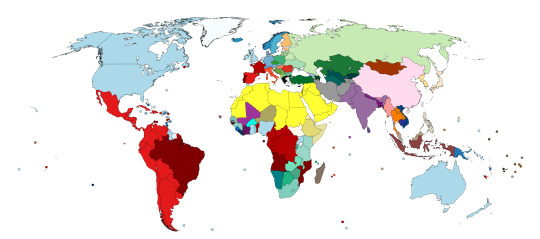

I had to separate the legend from the map because it would not have been legible otherwise. I am aware that the color distinctions are not always very clear, but there are only so many colors in the palette.
The legend is arranged in alphabetical order and languages are grouped by family (bullet points), with branches represented by numbers and followed by the color palette languages within them are colored in, as follows:
Afroasiatic
Chadic (Hausa) — ocher
Cushitic (Oromo and Somali) — light yellow-green
Semitic (from Arabic to Tigrinya) — yellow
Albanian — olive green
Armenian — mauve
Atlantic-Congo
Benue-Congo (from Chewa to Zulu) — blue-green
Senegambian (Fula and Wolof) — faded blue-green
Volta-Congo (Ewe and Mooré) — bright blue-green
Austroasiatic (Khmer and Vietnamese) — dark blue-purple
Austronesian
Eastern Malayo-Polynesian (from Fijian to Wallisian) — dark brown
Malayo-Polynesian (Palauan) — bright brown
Western Malayo-Polynesian (from Malagasy to Tagalog) — light brown
Eastern Sudanic (Dinka) — foral white
Hellenic (Greek) — black
Indo-European
Germanic (from Danish to Swedish) — light blue (creoles in medium/dark blue)
English-based creoles (from Antiguan and Barbudan to Vincentian Creole)
Indo-Aryan (from Bengali to Sinhala) — purple
Iranian (Persian) — gray
Romance (from Catalan to Spanish) — red (creoles in dark red)
French-based creoles (from Haitian Creole to Seychellois Creole)
Portuguese-based creoles (from Cape Verdean Creole to Papiamento)
Slavic — light green (from Bulgarian to Ukrainian)
Inuit (Greenlandic) — white
Japonic (Japanese) — blanched almond
Kartvelian (Georgian) — faded blue
Koreanic (Korean) — yellow-orange
Kra-Dai (Lao and Thai) — dark orange
Mande (from Bambara to Mandinka) — magenta/violet
Mongolic (Mongolian) — red-brown
Sino-Tibetan (Burmese, Chinese*, and Dzongkha) — pink
Turkic (from Azerbaijani to Uzbek) — dark green
Uralic
Balto-Finnic (Estonian and Finnish) — light orange
Ugric (Hungarian) — salmon
* Chinese refers to Cantonese and Mandarin. Hindi and Urdu are grouped under Hindustani, and Bosnian, Croatian, Montenegrin, and Serbian are grouped under Serbo-Croatian.
#langblr#lingblr#spanish#english#french#german#catalan#russian#mandarin#hausa#somali#arabic#albanian#armenian#swahili#ewe#moore#wolof#vietnamese#samoan#palauan#malay#dinka#greek#tok pisin#hindustani#persian#haitian creole#papiamento#greenlandic
57 notes
·
View notes
Text

A Call to Repentance
1 Gather yourselves together, yes, gather together, you nation that has no shame,
2 before the appointed time when the day passes as the chaff, before the fierce anger of the LORD comes on you, before the day of the LORD's anger comes on you.
3 Seek the LORD, all you humble of the land, who have kept his ordinances. Seek righteousness. Seek humility. It may be that you will be hidden in the day of the LORD's anger.
4 For Gaza will be forsaken, and Ashkelon a desolation. They will drive out Ashdod at noonday, and Ekron will be rooted up.
5 Woe to the inhabitants of the sea coast, the nation of the Cherethites. The word of the LORD is against you, Canaan, the land of the Philistines. I will destroy you, that there will be no inhabitant.
6 The sea coast will be pastures, with cottages for shepherds and folds for flocks.
7 The coast will be for the remnant of the house of Judah. They will find pasture. In the houses of Ashkelon, they will lie down in the evening, for the LORD, their God, will visit them, and restore them.
8 I have heard the reproach of Moab, and the insults of the people of Ammon, with which they have reproached my people, and magnified themselves against their border.
9 Therefore as I live, says the LORD of hosts, the God of Israel, surely Moab will be as Sodom, and the people of Ammon as Gomorrah, a possession of nettles, and salt pits, and a perpetual desolation. The remnant of my people will plunder them, and the survivors of my nation will inherit them.
10 This they will have for their pride, because they have reproached and magnified themselves against the people of the LORD of hosts.
11 The LORD will be awesome to them, for he will famish all the gods of the land. Men will worship him, everyone from his place, even all the shores of the nations.
12 You Cushites also, you will be killed by my sword.
13 He will stretch out his hand against the north, destroy Assyria, and will make Nineveh a desolation, as dry as the wilderness.
14 Herds will lie down in the midst of her, all the animals of the nations. Both the pelican and the porcupine will lodge in its capitals. Their calls will echo through the windows. Desolation will be in the thresholds, for he has laid bare the cedar beams.
15 This is the joyous city that lived carelessly, that said in her heart, "I am, and there is none besides me." How she has become a desolation, a place for animals to lie down in. Everyone who passes by her will hiss, and shake their fists. — Zephaniah 2 | New Heart English Bible (NHEB) The New Heart English Bible is in the public domain. Cross References: Genesis 19:24; Exodus 4:31; Deuteronomy 29:23; Joshua 5:9; Ruth 1:6; 1 Samuel 30:14; 2 Chronicles 20:4; Job 16:4; Psalm 22:26; Psalm 45:4; Psalm 72:8; Psalm 72:10; Psalm 102:6; Isaiah 5:17; Isaiah 7:25; Isaiah 10:5; Isaiah 10:16; Isaiah 14:29-30; Isaiah 15:1; Isaiah 16:6; Isaiah 17:13; Isaiah 18:1; Isaiah 20:4; Jeremiah 3:3; Jeremiah 4:4; Jeremiah 6:4; Lamentations 1:9; Ezekiel 25:16; Revelation 18:2; Revelation 18:7
Zephaniah 2 - Smith's Bible Commentary
#call to repentance#judgment on the philistines#judgment on Moab and Ammon#judgment on Cush and Assyria#Zephaniah 2#Book of Zephaniah#Old Testament#NHEB#New Heart English Bible
16 notes
·
View notes
